-
Countries
-
Data and Analysis
-
Special Focus
-
Crisis Responses
Event Tracking
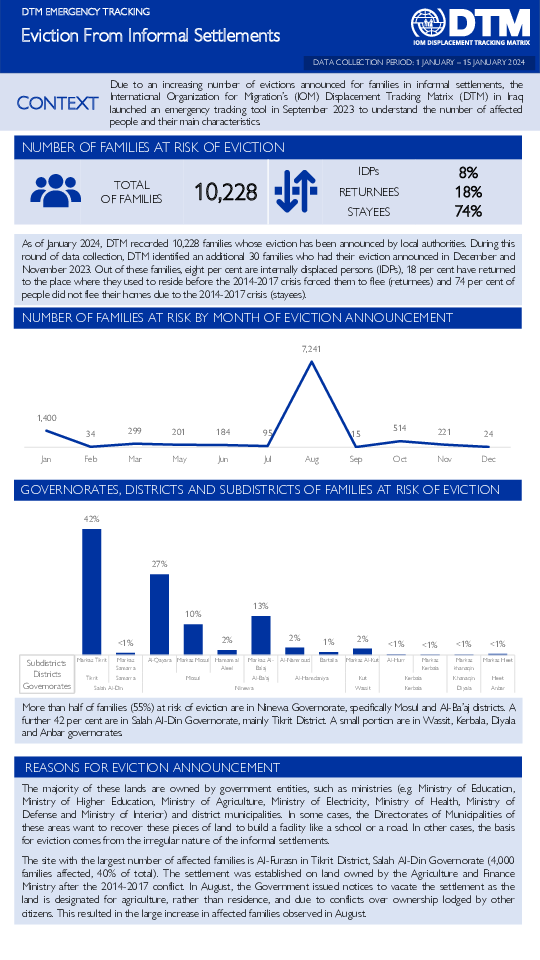
Contact
IraqDTM@iom.int
Language
English
Location
Iraq
Period Covered
Jan 01 2024
Jan 15 2024
Activity
- Mobility Tracking
- Event Tracking
Due to an increasing number of evictions announced for families in informal settlements, the International Organization for Migration’s (IOM) Displacement Tracking Matrix (DTM) in Iraq launched an emergency tracking tool in September 2023 to understand the number of affected people and their main characteristics
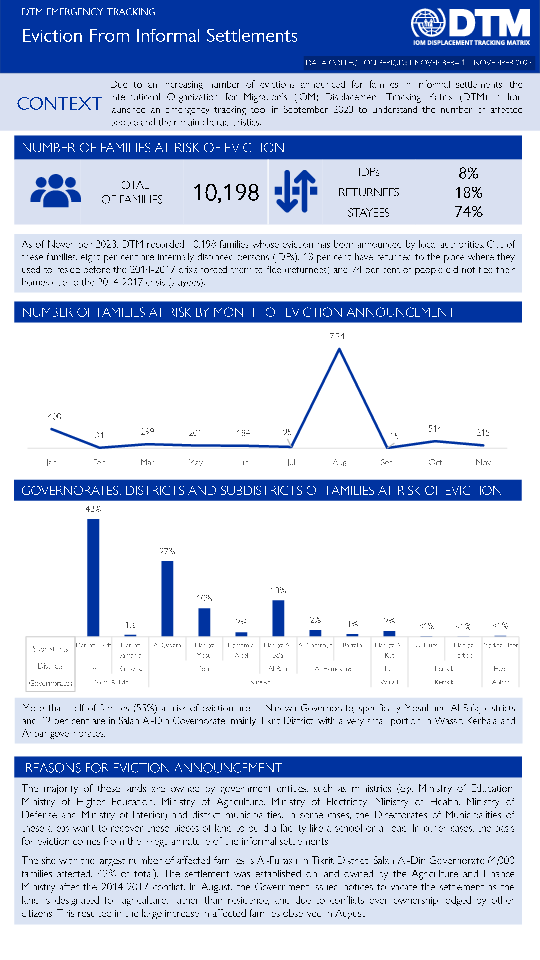
Contact
IraqDTM@iom.int
Language
English
Location
Iraq
Period Covered
Nov 01 2023
Nov 14 2023
Activity
- Mobility Tracking
- Event Tracking
Due to an increasing number of evictions announced for families in informal settlements, the International Organization for Migration’s (IOM) Displacement Tracking Matrix (DTM) in Iraq launched an emergency tracking tool in September 2023 to understand the number of affected people and their main characteristics.

Contact
DTM Nigeria, iomnigeriadtm@iom.int
Language
English
Location
Nigeria
Period Covered
Apr 01 2024
Apr 07 2024
Activity
- Mobility Tracking
- Event Tracking
Between 1 and 7 April 2024, a total of 1,223 new arrivals were recorded at locations in Adamawa and Borno states. The new arrivals were recorded at locations in Askira/Uba, Bama, Chibok, Damboa, Dikwa, Gwoza, Kaga, Kala Balge, and Monguno Local Government Areas (LGAs) of the most conflict-affected Borno State, and in Fufore, Girei, Gombi, Hong, Madagali, Maiha, Michika, Mubi North, Mubi South, Numan, Song, Yola North and Yola South LGAs of Adamawa State.
ETT assessments identified the following movement triggers: family re-unification (407 individuals or 33%), poor living conditions (261 individuals or 21%), improved security (176 individuals or 14%), fear of attack (175 individuals or 14%), military operations (94 individuals or 8%), access to humanitarian services (56 individuals or 5%) and seasonal farming (54 individuals or 5%).

Contact
DTM Burundi, DTMBurundi@iom.int
Language
French
Location
Burundi
Period Covered
Mar 31 2024
Apr 07 2024
Activity
- Mobility Tracking
- Event Tracking
La DTM a identifié 16 182 personnes affectées et 832 personnes déplacées par les inondations, les pluies torrentielles, et les glissements de terrain.
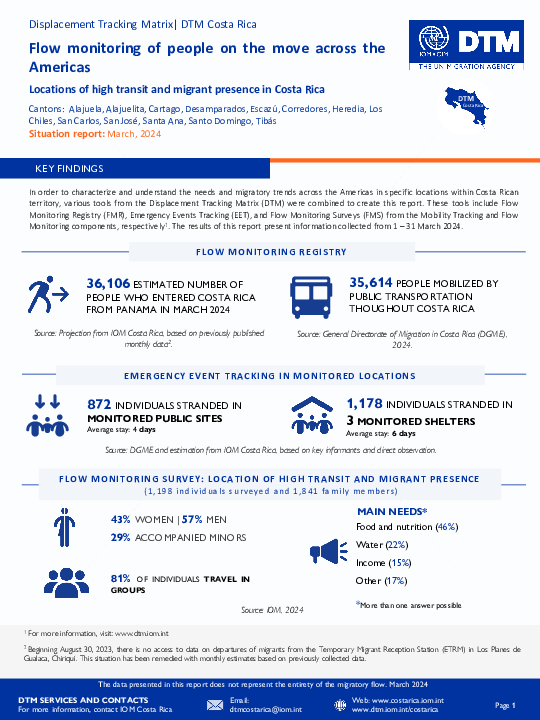
Contact
DTMCostaRica@iom.int
Language
English
Location
Costa Rica
Period Covered
Mar 01 2024
Mar 31 2024
Activity
- Flow Monitoring
- Mobility Tracking
- Event Tracking
Cantons: Alajuela, Alajuelita, Cartago, Desamparados, Escazú, Corredores, Heredia, Los Chiles, San Carlos, San José, Santa Ana, Santo Domingo, Tibás
Costa Rica, like the other countries in the Central American region, has been characterized as a migratory corridor for people who transit by land from the south to the north of America and whose destination is the countries in the north of the continent. This flow on the move through the Americas is mainly made up of people from the Bolivarian Republic of Venezuela, Cuba, Haiti, Ecuador, as well as people from other countries in South America, Africa and Asia.
According to estimations from IOM Costa Rica, during March 36,106 people entered the country, an approximate average of 1,165 people per day and estimating a decrease of 13% compared to February 2024. In addition, 1,178 people stranded in the monitored shelters were identified and 872 people stranded in the public places visited.
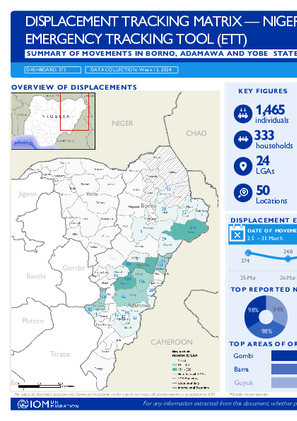
Contact
DTM Nigeria, iomnigeriadtm@iom.int
Language
English
Location
Nigeria
Period Covered
Mar 25 2024
Mar 31 2024
Activity
- Mobility Tracking
- Event Tracking
Between 25 and 31 March 2024, a total of 1,465 new arrivals were recorded at locations in Adamawa and Borno states. The new arrivals were recorded at locations in Askira/Uba, Bama, Chibok, Dikwa, Gwoza, Hawul, Kala Balge, Konduga, Mafa, Monguno and Ngala Local Government Areas (LGAs) of the most conflict-affected Borno State, and in Fufore, Girei, Gombi, Guyuk, Hong, Lamurde, Madagali, Maiha, Michika, Numan, Song, Yola North and Yola South LGAs of Adamawa State.
ETT assessments identified the following movement triggers: family re-unification (291 individuals or 20%), seasonal farming (227 individuals or 15%), poor living conditions (214 individuals or 15%), improved security (213 individuals or 14%), military operations (199 individuals or 14%), attack (186 individuals or 13%), fear of attack (78 individuals or 5%) and access to humanitarian support (57 individuals or 4%).
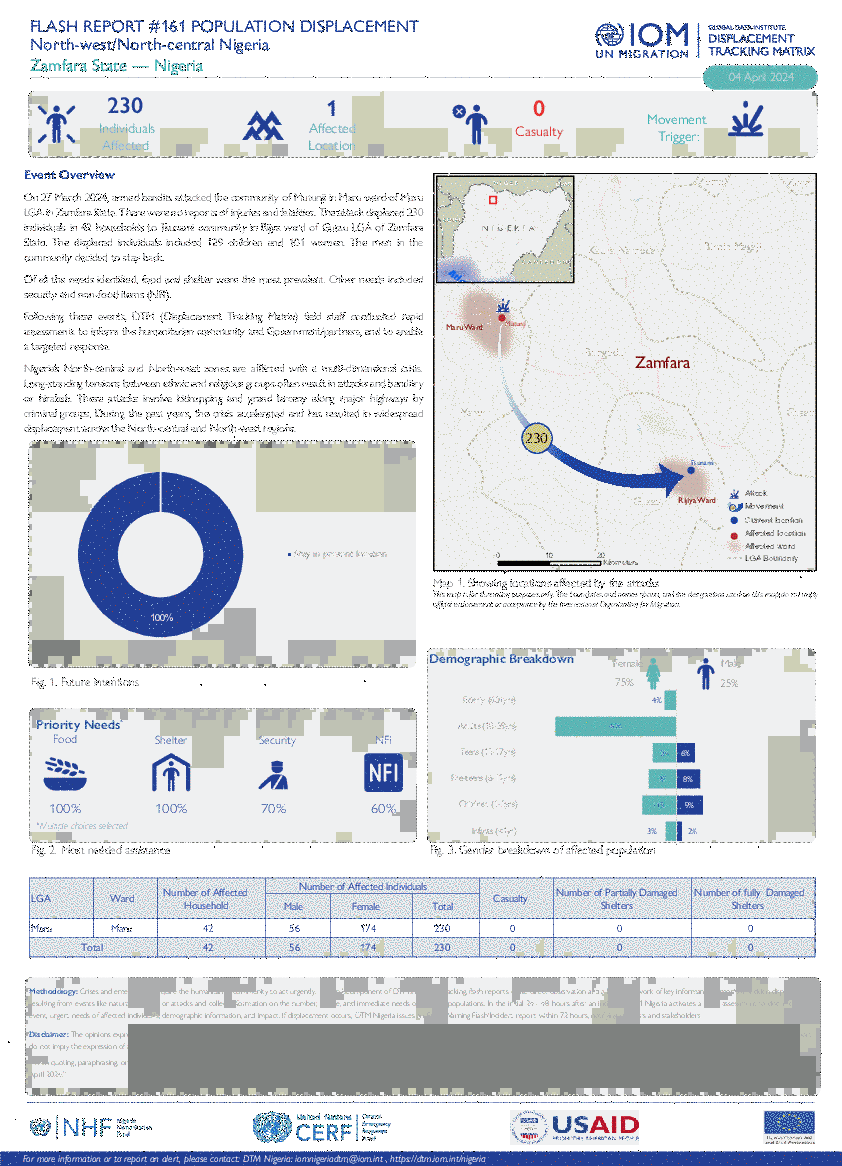
Contact
DTM Nigeria, iomnigeriadtm@iom.int
Language
English
Location
Nigeria
Period Covered
Mar 25 2024
Mar 31 2024
Activity
- Mobility Tracking
- Event Tracking
On 27 March 2024, armed bandits attacked the community of Mutunji in Maru ward of Maru LGA in Zamfara State. There were no reports of injuries and fatalities. The attack displaced 230 individuals in 42 households to Tsunami community in Rijya ward of Gusau LGA of Zamfara State. The displaced individuals included 129 children and 101 women. The men in the community decided to stay back.
Of all the needs identified, food and shelter were the most prevalent. Other needs included security and non-food items (NFI).
Following these events, DTM (Displacement Tracking Matrix) field staff conducted rapid assessments to inform the humanitarian community and Government/partners, and to enable a targeted response.
Nigeria’s North-central and North-west zones are afflicted with a multi-dimensional crisis. Long-standing tensions between ethnic and religious groups often result in attacks and banditry or hirabah. These attacks involve kidnapping and grand larceny along major highways by criminal groups. During the past years, the crisis accelerated and has resulted in widespread displacement across the North-central and North-west regions.
Contact
DTM Yemen, iomyemendtm@iom.int
Location
Yemen
Activity
- Mobility Tracking
- Event Tracking
Period Covered
Mar 31 2024 -Apr 06 2024
From 1 January to 6 April 2024, IOM Yemen DTM tracked 947 households (HH) (5,682 Individuals) who experienced displacement at least once.
Between 31 March and 6 April 2024, IOM Yemen DTM tracked 34 households (204 individuals) displaced at least once. The majority of people moved into/within the following governorates and districts:
- Ma’rib (32 HHs) – Ma’rib City (17 HHs), Ma’rib (10 HHs), Harib (5 HHs) districts. Most displacements in the governorate originated from Al Hodeidah and Ma’rib.
- Al Hodeidah (2 HHs) – Hays (2 HHs) district. All displacements in the governorate originated from Ta’iz.
The majority of people moved from the following governorates and districts:
- Al Hodeidah (9 HHs) – Bajil (5 HHs), Az Zaydiah (2 HHs), At Tuhayta (2 HHs) districts.
- Ta’iz (5 HHs) – Maqbanah (2 HHs), Jabal Habashi (1 HH), Sharab As Salam (1 HH) districts.
- Ma’rib (5 HHs) – Al Abdiyah (3 HHs), Harib (1 HH), Raghwan (1 HH) districts.
Population Groups
Survey Methodology
Unit of Analysis Or Observation
Type of Survey or Assessment
Keywords
Geographical Scope
Administrative boundaries with available data
The current dataset covers the following administrative boundaries
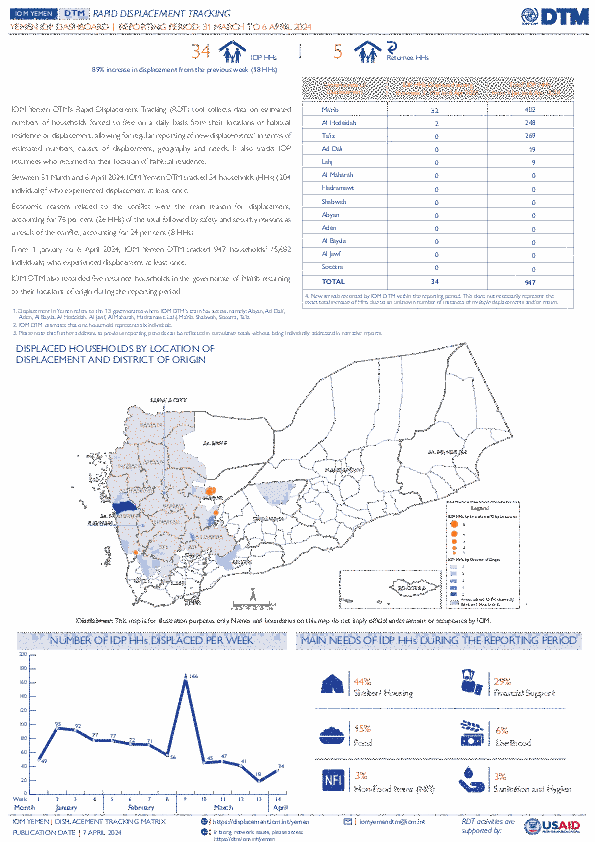
Contact
DTM Yemen, iomyemendtm@iom.int
Language
English
Location
Yemen
Period Covered
Mar 31 2024
Apr 06 2024
Activity
- Mobility Tracking
- Event Tracking
IOM Yemen DTM’s Rapid Displacement Tracking (RDT) tool collects data on estimated numbers of households forced to flee on a daily basis from their locations of origin or displacement, allowing for regular reporting of new displacements in terms of estimated numbers, geography, and needs. It also tracks returnees who returned to their location of origin.
From 1 January to 6 April 2024, IOM Yemen DTM tracked 947 households (HH) (5,682 Individuals) who experienced displacement at least once.
Between 31 March and 6 April 2024, IOM Yemen DTM tracked 34 households (204 individuals) displaced at least once. The majority of people moved into/within the following governorates and districts:
- Ma’rib (32 HHs) – Ma’rib City (17 HHs), Ma’rib (10 HHs), Harib (5 HHs) districts. Most displacements in the governorate originated from Al Hodeidah and Ma’rib.
- Al Hodeidah (2 HHs) – Hays (2 HHs) district. All displacements in the governorate originated from Ta’iz.
The majority of people moved from the following governorates and districts:
- Al Hodeidah (9 HHs) – Bajil (5 HHs), Az Zaydiah (2 HHs), At Tuhayta (2 HHs) districts.
- Ta’iz (5 HHs) – Maqbanah (2 HHs), Jabal Habashi (1 HH), Sharab As Salam (1 HH) districts.
- Ma’rib (5 HHs) – Al Abdiyah (3 HHs), Harib (1 HH), Raghwan (1 HH) districts.
IOM identified 9 households displaced in the previous reporting period, which covered 24 - 30 March 2024, in the governorates of Ma'rib (6 HHs), Al Hodeidah (2 HHs), and Ta’iz (1 HH). These figures have been added to the cumulative displacement total recorded since the beginning of the year.

Contact
DTM DRC, iomdrcdtm@iom.int
Language
English
Location
Democratic Republic of the Congo
Period Covered
Mar 14 2024
Mar 29 2024
Activity
- Mobility Tracking
- Event Tracking
In the eastern region of the Democratic Republic of Congo (DRC), particularly in North Kivu province, a prolonged and increasingly complex conflict persists, characterized by the presence of numerous armed groups, including the M23 group and the Congolese Armed Forces (FARDC) and their respective allies. Since the beginning of this year, the M23 has been advancing in the eastern part of the DRC, particularly towards Goma, which serves as the capital of North Kivu. Recent actions by the M23 suggest their intention to take control of Goma, potentially marking their second occupation of the city after a brief period of control in 2012.
Since the onset of the crisis, the International Organization for Migration (IOM), through the Displacement Tracking Matrix (DTM) continues to conduct a series of rapid assessments, including Emergency Tracking (EET/ERM), Crisis Analysis and
Registration activities, addressing immediate information needs with a view to understanding displacement dynamics and needs. This report presents the results of assessments carried out in the various displacement and return areas from 14 to 29 March 2024.
Pagination
- Previous page
- Page 36
- Next page
